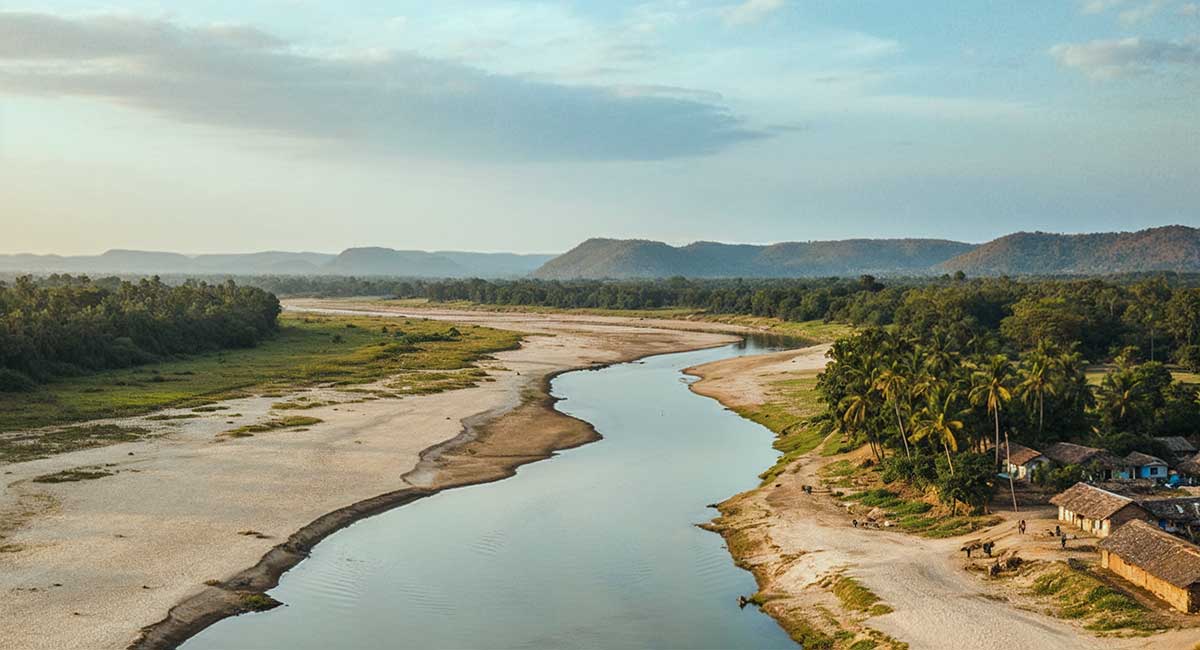Budhabalanga River in Odisha
Situated in Odisha, India, the Budhabalanga River is a natural marvel with deep cultural, ecological, and historical significance. Though not as widely known as some of the more famous rivers of India, the Budhabalanga is a stunning waterway with a rich ecosystem and a fascinating story to tell. This river offers a unique blend of scenic beauty, serenity, and local culture, making it an intriguing destination for those who love exploring off-the-beaten-path places.
A Look into the Budhabalanga River
The Budhabalanga River is primarily located in the northern part of Odisha, flowing through the districts of Mayurbhanj and Balasore. The river is part of the Mahanadi Basin, one of India’s largest river systems. The river begins its journey from the lower ranges of the Eastern Ghats, passing through lush forests, rural landscapes, and villages before eventually merging with the Bay of Bengal. The river spans about 180 kilometers and is a vital water source for the region’s agriculture and local communities.
One of the unique aspects of the Budhabalanga River is its relatively untouched nature. Despite its importance to the locals, it has not been as commercialized or developed as other rivers in India. This gives the river an aura of tranquility and untouched beauty, ideal for nature lovers and explorers seeking something different from the crowded tourist spots.
The Beauty of Budhabalanga
The Budhabalanga River is renowned for its natural beauty, surrounded by dense forests, lush green landscapes, and hills. The river offers breathtaking views, with its clear waters flowing through serene surroundings. During the monsoon season, the river swells, becoming even more majestic. The months of October through March are the ideal times to go because of the nice weather and the opportunity to completely enjoy the river’s splendor.
The river is home to various species of birds and aquatic life, making it a popular spot for birdwatching and fishing. The surrounding forests shelter wildlife, including tigers, elephants, and deer. For eco-tourists, the river’s banks are perfect for scenic walks, nature treks, or simply sitting by the river and enjoying the calming ambiance.
The Budhabalanga River’s Role in Local Life
For centuries, the Budhabalanga River has been a lifeline for the people in its vicinity. It has played a crucial role in the region’s agricultural economy. The river’s water is used for irrigation, supporting the cultivation of rice, sugarcane, vegetables, and other crops. The local population relies heavily on the river for their daily water needs, making it an indispensable part of their lives.
In addition to its agricultural significance, the river also supports the local fishing industry. The river’s fish resources provide a steady source of income for the local communities, with fishermen regularly setting out on boats to catch fish. The river has become a cornerstone of rural livelihoods, fostering a symbiotic relationship between the river and the people.
Cultural and Historical Significance
Like many rivers in India, the Budhabalanga holds deep cultural significance. Local communities have long associated the river with religious rituals and ceremonies. It is a sacred site for worshippers and devotees because of the many temples and shrines that border its banks. The locals often consider the river a holy entity, and they revere its waters and offer prayers for prosperity, health, and happiness.
In addition to its religious importance, the Budhabalanga River has historical value. The region surrounding the river has been home to several ancient civilizations and kingdoms, many of which left behind traces of their existence. During ancient times, the river was a vital conduit for trade and transportation, allowing people and products to move between various areas. The people of the area wove the river into their myths and folklore and passed them down through the centuries.
How to Reach the Budhabalanga River?
The Budhabalanga River is easily accessible from major cities in Odisha like Bhubaneswar and Cuttack. The nearest airport is Biju Patnaik International Airport in Bhubaneswar, which connects the region to the rest of India. You can take a bus or a taxi to the river from there. Alternatively, Balasore, located close to the river, connects by road and rail to various parts of the state.
Final Thoughts
The Budhabalanga River is an unspoiled treasure in Odisha, blending natural beauty, cultural significance, and historical importance. Whether you’re drawn to its scenic landscapes, cultural heritage, or role in local life, visiting this river promises to be a refreshing experience. The Budhabalanga River is an excellent choice for anyone looking for an off-the-beaten-path location that provides peace, beauty, and an insight into Indian rural life.


